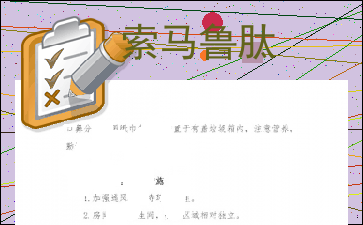索马鲁肽
以下为《索马鲁肽》的无排版文字预览,完整格式请下载
下载前请仔细阅读文字预览以及下方图片预览。图片预览是什么样的,下载的文档就是什么样的。
NDA # 209637 Reviewer: Federica Basso, Ph.D 4 Pharmacology 4.1 Primary Pharmacology Pharmacology studies have been conducted in vitro and in vivo in diabetic mice, normal and obese rats and normal pigs and minipigs. Semaglutide activated the human GLP-1 receptor measured as cAMP release from baby hamster kidney (BHK) cells expressing the cloned human GLP-1 receptor with a potency comparable to liraglutide and approximately 8-fold lower than native GLP-1. The receptor binding affinity of semaglutide (NNC ***7) is comparable to liraglutide and GLP-1 in the presence of 0.005% albumin, but it decreased more than for liraglutide in the presence of 2% albumin compared with GLP-1. The lower affinity at the higher albumin concentration is explained by a stronger albumin binding of semaglutide than liraglutide. In isolated perfused rat pancreas semaglutide stimulated insulin secretion with an EC50 of approximately 13 nM (data not shown). Increase in glucose-stimulated plasma insulin concentration, decrease in blood glucose, and decrease in body weight gain were observed in Wistar rats and diabetic db/db mice after a single subcutaneous administration. Semaglutide (NNC 0113-0217) was more potent than liraglutide (NNC 0090-1170) in lowering blood glucose level (ED50: 0.30 and 6.9 nmol/kg, respectively, at 6h post-dose); however, reduction in blood glucose was similar between semaglutide and liraglutide. In C57BL mice, food intake was lower with semaglutide than with liraglutide. 23 Reference ID: *** NDA # 209637 Reviewer: Federica Basso, Ph.D Figure 1. Plasma insulin and blood glucose in Wistar rats (Applicant’s figure) Figure 2. Non-linear curve fits for estimating ED50 of 6h blood glucose lowering (Applicant’s figure) 24 Reference ID: *** NDA # 209637 Reviewer: Federica Basso, Ph.D Figure 3. Delta blood glucose in diabetic db/db mice (Applicant’s figure) Figure 4. Body weight change at 48h post-dose in diabetic db/db mice (Applicant’s figure) 25 Reference ID: *** NDA # 209637 Reviewer: Federica Basso, Ph.D Figure 5. Cumulative food intake in C57Bl/6 mice (Applicant’s figure) Following repeated doses of semaglutide, the following effects were observed: 鸱 Lower blood glucose and HbA1c, increased insulin secretion and beta-cell mass in diabetic db/db mice treated for 4 weeks. 鸱 Decreased body weight and selectively reduced chocolate intake in diet-induced obese (DIO) rats fed with chow and chocolate ad libitum for approximately 9 months prior to initiation of treatment (77 day). 鸱 Sustained decrease in food intake and increased insulin secretion for up to 7 days after the last dose in minipigs. 鸱 Increased mRNA levels of the satiety peptide cocaine- and amphetamineregulated transcript (CART) and decrease in the hunger signals neuropeptide Y (NPY) and agouti-related peptide (AgRP) in the hypothalamic arcuate nucleus (ARC) of diet induced obese mice administered semaglutide for 18 days. No effects were observed in the paraventricular hypothalamic nucleus (PVN; data not shown). 鸱 Semaglutide activated hypothalamic POMC/CART neurons, and inhibited NPY/AGRP neurons in mice. Semaglutide was found in select circumventricular organs {(the area postrema (AP), the median eminence (ME), the subfornical organ (SFO), the organum vasculosum of lamina terminalis (OVLT), and the choroid plexus (ChP)}, in the arcuate nucleus (ARC), the lateral septal nucleus (LS), the septofimbral nucleus (SFi), the nucleus tractus solitarus (NTS) and the dorsal motor nucleus of vagus (10N). The detection of the semaglutide in these brain regions, except from the ChP and the fenestrated capillaries in ME, was dependent on GLP-1R as the signal was absent in GLP-1R-/- mice. 26 Reference ID: *** NDA # 209637 Reviewer: Federica Basso, Ph.D Figure 6. HbA1c in db/db mice during once-daily SC dosing of semaglutide (Applicant’s figure) Figure 7. Beta-cell islet number and glucose-induced insulin secretion in diabetic db/db mice after four weeks semaglutide treatment (Applicant’s figure) Figure 8. Body weight in DIO rats after 77 days semaglutide treatment (Applicant’s figure) 27 Reference ID: *** NDA # 209637 Reviewer: Federica Basso, Ph.D Figure 9. Chow (C) and chocolate (CH) intake in rats after 77 day of dosing (Applicant’s figure) Figure 10. Insulin secretion in clamped minipigs (Applicant’s figure) 28 Reference ID: *** NDA # 209637 Reviewer: Federica Basso, Ph.D Figure 11. Food intake in minipigs after subcutaneous dosing of semaglutide (Applicant’s figure) Table 2. Effect of semaglutide on AgRP, NPY, CART, and POMC mRNA in the arcuate nucleus (Applicant’s figure) 29 Reference ID: *** NDA # 209637 Reviewer: Federica Basso, Ph.D Figure 12. Effect of semaglutide on the neuronal activity of POMC neurons (Applicant’s figure) Figure 13. Effect of semaglutide on the neuronal activity of NPY/AgRP neurons (Applicant’s figure) 30 Reference ID: *** NDA # 209637 Reviewer: Federica Basso, Ph.D Table 3. VivoTag750-semaglutide signal in the brain (Applicant’s table) 4.2 Secondary Pharmacology Semaglutide does not bind the human glucagon receptor. In a Broad Receptor Profile assay, semaglutide showed an approximately 72% negative inhibition of binding/activity at the thyroid hormone receptor. Negative inhibition (augmentation of ligand binding) is generally considered non-specific, and is rarely of pharmacological consequence. The repeat dose toxicity studies showed no indication of thyroidtoxicosis. A result of greater than 50% inhibition or stimulation was not observed for any other receptor, channel, or transporter. 4.3 Safety Pharmacology Safety pharmacology studies were conducted in vitro and in vivo to investigate the effect of semaglutide on central nervous system, cardiovascular and respiratory system, and renal function. CNS Abnormal gait (walking on toes), decreased touch response, passivity, increased urination, dirty muzzle, lethargy and piloerection were observed in rats administered 0.095 mg/kg at 0-8 hours after administration (~6X the estimated clinical starting dose, based on Cmax). The increased urination and passivity were still present 24 hours post- 31 Reference ID: *** NDA # 209637 Reviewer: Federica Basso, Ph.D Table 5. Pharmacokinetic parameters for male rats following single SC dose (Applicant’s table) Renal function Increased urine volume and sodium, potassium, and chloride concentrations were observed at >0.023 mg/kg between 0 and 8 hours post dose (请点击下方选择您需要的文档下载。
- 索马鲁肽
- 英语小作文模板
- Summer vacation 八下期末测试
- 补全对话常用句子
- 词汇短语大全
- 全国硕士研究生入学统一考试英语试题
- Unit-1-Fresh-start练习答案综合教程三
- 雅思听力 807 单词升级版单某某
- 英语建议信修改
- 教学设计课题NewZealand
- 英语作文建议信
- 自考英语二自学教程(2012版)纯答案
- 2016年12月四级第一套答案及解析
- Module 1 Unit 1 She‘s very nice. 习题
以上为《索马鲁肽》的无排版文字预览,完整格式请下载
下载前请仔细阅读上面文字预览以及下方图片预览。图片预览是什么样的,下载的文档就是什么样的。
